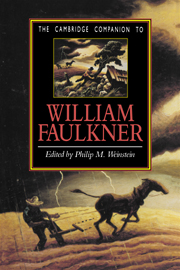5 - Looking for a Master Plan
Faulkner, Paredes, and the Colonial and Postcolonial Subject
from Part I - The Texts in the World
Published online by Cambridge University Press: 28 May 2006
Summary
Much has been written about Faulkner’s attitudes toward class and race and about his representations of these issues as the fundamental structures of his most successful fictions. Myra Jehlen, notably, argues for the determining role of the category of class in novels such as Saitohs, The Unvanquished, and especially The Sound and the Fury and Absalom, Absalom!. Although she does not ignore the centrality of race, Jehlen claims that the reigning problematic in Faulkner’s account of Southern antebellum history is the internal class conflict between two sectors of white agrarian society - the lordly, cavalier plantation class versus the Jeffersonian, homesteading, working-class peasantry. In a deconstructive analysis of Absalom, Absalom! that raises questions of race and class in a related but divergent register, Richard C. Moreland shows how the various narrative strategies of Faulkner’s novel are intended to avert the recognition of this struggle between classes and to disregard the insistent presence of other narratives that underscore the additional pressures of race and gender in Sutpen’s story.
As a classic instance of this paradigmatic structure of revelation and aversion in Faulkner’s major works, Absalom, Absalom! reflects the ideologies of the historical era in which it was composed, the mid-Depression years of early-twentieth-century America. These ideologies underlie Faulkner’s connection with the issues of coloniality and postcoloniality that began to appear in much American, Latin American, and European literature of the immediate pre-World War II years.
- Type
- Chapter
- Information
- The Cambridge Companion to William Faulkner , pp. 96 - 120Publisher: Cambridge University PressPrint publication year: 1995
- 3
- Cited by



